
Wine Culture and Information since 2002 - Volume 22
 Wine Culture and Information since 2002 - Volume 22 |
|
Comparing NebbioloA great grape for great wine, Nebbiolo divides and amazes the senses of wine lovers. Strong, crisp and robust, nevertheless generous in its elegance and personality |
|
Nebbiolo is a grape that - in a way or another - is frequently the protagonist of discussions about wine. Appreciated and praised by many for its full body and class, less appreciated by others who consider it too much harsh, crisp and imposing. Also subject of discussions among the producers who debate on the way it should be vinified, Nebbiolo is one of the many famous autochthonous grapes of Italy appreciated and renowned abroad. Talking about Nebbiolo means recalling to mind a specific region of Italy - Piedmont, its homeland - however it is also found in Lombardy, in Vallée d'Aoste and even in Sardinia. Despite the most frequent association with Nebbiolo is Barolo and Barbaresco, the famous grape from Piedmont is also protagonist in Roero, Carema and Valtellina Superiore, it is also found in the red wines of Franciacorta and many red of Vallée d'Aoste. In Sardinia it is mainly found in the Northern area, in Gallura. According to a viticultural point of view, Nebbiolo is a late ripening grape, usually when in Piedmont's Langhe comes the fog (nebbia in Italian), from which probably derives its name. Nebbiolo is a singular grape, capable of making wines which are very different from the rest. Among the grapes with the highest content in tannins, Nebbiolo is pretty acid with a moderate content in coloring substances. For this reason its wines generally show an appreciable transparency and in the mouth can be recognized for their high astringency and crispness, the latter being pretty uncommon in red wines. For this reason, the wines produced with Nebbiolo generally have a pretty high alcohol by volume, in order to balance both the high content of tannins and acidity. Nebbiolo is a pretty difficult grape also according to a viticultural and enological point of view and making a great wine from this grape is an enterprise reserved to few. However, when quality of grape meets enological quality, wines produced with Nebbiolo are examples of extraordinary class and elegance, associated to a full body, usually defined as a fist wrapped in a velvet glove.
|
|
Wines produced with Nebbiolo, quality ones and well made, are always an unique experience for every taster. Whoever expects round and gentle wines, in Nebbiolo will not probably find satisfaction. The ones looking for elegance and class supported by a full body, Nebbiolo is the right wine. Wines produced with Nebbiolo are not only power, tannins and acidity: its refined and elegant aromas represent in fact a world on its own of fruits and flowers, as well as extremely complex aromas that only time can give wines. Time will also give wines produced with Nebbiolo the grace of roundness, when the astringency of its tannins will get milder while increasing elegance. For this reason, Nebbiolo is always vinified in cask and, in pretty recent times, in barrique: the passage in wood in fact helps to mitigate the strong astringency also thanks to the beneficial and slow oxidation. However, the strong content in tannins and acidity are one of the best characteristics of Nebbiolo, not only according to an organoleptic point of view, but also to an enological point of view as they ensure, together with alcohol, very long times of aging and evolution.
Our comparative tasting about Nebbiolo will evaluate three wines coming from three of the areas considered to be famous for this grape: two of them are from Piedmont's Langhe - Barolo and Barbaresco - whereas the third one comes from Valtellina, in the northern part of Lombardy. The three wines have been chosen according to their organoleptic qualities and the vinification technique. Also the Valtellina Superiore of our comparative tasting, despite the production disciplinary allows the use of other grapes, is made with 100% Nebbiolo, a grape also known in that area as Chiavennasca. The first wine of our comparative tasting is Sandrone's Barolo Cannubi Boschis, aged for 24 months in cask. The second wine, also coming from Piedmont, is Sottimano's Barbaresco Cottà, aged for about 20 months in barrique. The last wine is Caven Camuna's Valtellina Superiore Sassella La Priora, aged in cask. The three wines will be tasted at a temperature of 18° C (64° F) and for all the three wines will be used ISO tasting glasses.
|
||||||||
|
One of the first qualities observed in the appearance of a wine produced with Nebbiolo is transparency. There is a common idea about great wines must always show a low transparency, most of the times impenetrable to light, in order to be considered of quality. Nebbiolo is one of the many grapes who can controvert this false conviction. Because of its moderate coloring capacity, in wines produced with Nebbiolo will be frequently observed a pretty high transparency, nothing that could remind, for example, wines produced with Cabernet Sauvignon. However, there are cases in which transparency is pretty low. The intensity of the color varies from ruby red in youth to a brick red color after many years of aging. Nuances in Nebbiolo tend to show garnet red color and sometimes a brick red color, a quality which is absolutely typical in this grape. After years of aging in bottle, a time that in quality Nebbiolo can be measured for more than ten years, the intensity of color will get brick red hues as well as in the nuances and the transparency will be increased. The first wine of which we will examine appearance is Caven Camuna's Valtellina Superiore Sassella La Priora. By holding the glass tilted on a white surface, we will begin by observing the liquid mass at the base of the glass, where it will be possible to see a brilliant ruby red color and a pretty evident transparency. The nuances of the wine, observed towards the opening of the glass, will show a garnet red color. Let's now pass to the evaluation of Sottimano's Barbaresco Cottà, in which it will be possible to observe a lower transparency than the precious wine, an intense ruby red color and garnet red nuances. The evaluation of the last wine, Sandrone's Barolo Cannubi Boschis, always to be done by holding the glass tilted on a white surface, will reveal the same colors observed in the previous wines: intense ruby red and garnet red nuances. Finally, it should be noticed the higher transparency in this Barolo as opposed to Sottimano's Barbaresco.
|
|
The olfactory analysis of Nebbiolo's aromas is a very interesting experience, in particular in those wines aged in bottle for a long time and in which develop very complex aromas. The world of Nebbiolo's aromas is characterized by red berried fruits and flowers, as well as by a series of aromatic nuances making quality wines produced with this grape an amazing sensorial experience. As Nebbiolo is generally vinified in cask, sometimes in barrique, tertiary aromas will always be present and with time they will get pretty complex qualities. Among the most common fruit aromas in Nebbiolo there are cherry and plum, whereas among aromas belonging to the world of flower there are violet and rose. With time Nebbiolo wines develop extremely interesting and complex aromas, such as leather, mushrooms, truffle and tar, to which are also added balsamic aromas of menthol. In these wines it is frequent the perception of aromatic herbs hints, of which the most common one is thyme. We will begin the olfactory analysis of the wine of our comparative tasting from Caven Camuna's Valtellina Superiore Sassella La Priora. By holding the glass in vertical position and without swirling, we will proceed with the evaluation of opening aromas. The first smell will allow the perception of the aromas of cherry, raspberry and violet: a very common combination in wines produced with Nebbiolo and that frequently identifies this grape. After having swirled the glass, we will proceed with the second smell, which will allow the perception of plum and strawberries jam aromas, a pleasing aroma of rose followed by the aromas of licorice, tobacco, menthol and vanilla. Finally, it should be noticed the pleasing hint of lavender flowers: a touch of class which can be found in many Nebbiolo wines. It should also be noticed the balsamic aroma of menthol, also in this case, typical in wines produced with this grape. Let's now proceed with the olfactory analysis of our comparative tasting with the second wine: Sottimano's Barbaresco Cottà. By holding the glass in vertical position and without swirling, it will be done the first smell which will reveal wine's opening aromas. From the glass will be possible to perceive aromas of cherry and plum, also in this case, typical in Nebbiolo. After having swirled the glass, and after having done the second smell, it will be possible to recognize the aromas of blueberry, dried violet, licorice, tobacco and vanilla. The olfactory perception will be completed by the aromas of mace, menthol, coffee and cocoa. Let's now pass to the evaluation of the aromas of the last wine of our comparative tasting: Sandrone's Barolo Cannubi Boschis. The first smell will reveal the opening aromas of cherry, plum, raspberry and violet, all of them being distinctive and typical aromas in Nebbiolo. After having swirled the glass, we will proceed with the second smell which will allow the perception of the aromas of strawberry, blackberry, blueberry, tobacco, licorice and vanilla. Moreover, it will also be perceived aromas of cocoa, cinnamon, mace, pink pepper and the typical balsamic hint of menthol. Finally, it should be noticed the good aromatic balance in all the three wines.
|
||||
|
There are many who define Nebbiolo as fist wrapped in a velvet glove because of its strong gustatory sensations expressed by the astringency of tannins and of its evident acidity. These two characteristics which - as a matter of fact - ensure Nebbiolo very long periods of aging, however require particular wine making practices in order to make the wine balanced. In fact, the aging in cask is beneficial to “smooth” the harshness of Nebbiolo therefore making the wine more balanced and, together with alcohol, that in Nebbiolo is pretty high and can reach 14.5%, can be obtained balanced wines. Aging and time will also allow the wine to get a better balance, when tannins will begin to lose their harshness while allowing roundness to develop. Astringency and acidity are the two main gustatory sensations which will be noticed in wines produced with Nebbiolo, sensations which tend to get balanced when in the mouth will begin the perception of the pseudo caloric action of alcohol. Despite its exuberant power, also in the gustatory analysis can be appreciated the elegance and the class of Nebbiolo. Let's begin the gustatory analysis from Caven Camuna's Valtellina Superiore Sassella La Priora. After the first sip, the wine shows its typical character: a tannic attack to which it is added the crispness given by acidity. Few moments later will be possible to perceive the effects of alcohol and of the structure in the balance. It should also be noticed the effect of the aging in wood on the balance of astringency and acidity. Let's now pass to the second wine, Sottimano's Barbaresco Cottà. Also the attack of this wine is characterized by an evident astringency and an appreciable acidity, well balanced by alcohol and roundness given by wood. Also the attack of the last wine, Sandrone's Barolo Cannubi Boschis, is not different from the two previous wines: pronounced astringency of tannins and appreciable crispness, well balanced by alcohol and roundness. It should however be noticed how all the three wines have an excellent balance and structure, tannins and acidity are always balanced by alcohol and roundness, in other words a fist wrapped in a velvet glove.
|
|
The three wines of our comparative tasting show three similar characters although different one from each other, expressions of the territories from which they are from. The finish of Caven Camuna's Valtellina Superiore Sassella La Priora is persistent with long flavors of cherry, plum and raspberry, three organoleptic qualities typical in Nebbiolo. The finish of Sottimano's Barbaresco Cottà is very persistent with long flavors of cherry and plum, also in this case, typical in Nebbiolo. The finish of Sandrone's Barolo Cannubi Boschis is very persistent with long flavors of cherry, plum and raspberry to which is added blueberry. It should be noticed how in the finish of all the three wines, besides the organoleptic gustatory sensations recalling the typical fruits of Nebbiolo, can also be perceived a thick texture thanks to the high structure. Because of its “strong” organoleptic qualities, Nebbiolo has always divided wine lovers: there is who loves and appreciates it, and who do not like it because of its exuberance, however, what it is certain, wines produced with this grape never leave the taster indifferent.
|
Wines of the Month |
|
|
|
Score legend Prices are to be considered as indicative. Prices may vary according to the country or the shop where wines are bought |

|
|
Petra Ruja 2005 |
|
| Cantina Li Seddi (Sardinia, Italy) | |
| Grapes: Cannonau, Bovale, Girò | |
| Price: € 6.48 | Score: |
| Petra Ruja shows a brilliant ruby red color and nuances of purple red, moderate transparency. The nose reveals intense, clean and pleasing aromas which start with hints of raspberry, cherry and plum followed by aromas of blueberry, cyclamen and strawberry. The mouth has good correspondence to the nose, a slightly tannic attack and pleasing crispness, however balanced by alcohol, good body, intense flavors. The finish is persistent with flavors of raspberry, plum and black cherry. Petra Ruja ages in steel tanks. | |
| Food Match: Cold cuts, Pasta with meat, Fish soups, Roasted white meat | |

|
|
Lu Ghiali 2005 |
|
| Cantina Li Seddi (Sardinia, Italia) | |
| Grapes: Cannonau, Muristeddu | |
| Price: € 10.00 | Score: |
| The wine shows a brilliant ruby red color and nuances of ruby red, moderate transparency. The nose denotes intense, clean and pleasing aromas which start with hints of plum and blueberry followed by aromas of black cherry, violet, cyclamen and arbutus berry. The mouth has good correspondence to the nose, a slightly tannic attack and however balanced by alcohol, good body, intense flavors. The finish is persistent with flavors of plum and blueberry. Lu Ghiali ages in steel tanks. | |
| Food Match: Roasted meat, Stewed and braised meat | |
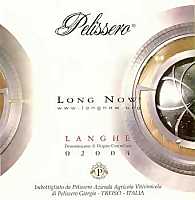
|
|
Langhe Rosso Long Now 2004 |
|
| Pelissero (Piedmont, Italy) | |
| Grapes: Barbera, Nebbiolo | |
| Price: € 20.00 | Score: |
| This wine shows a deep ruby red color and nuances of ruby red, impenetrable to light. The nose reveals intense, clean, pleasing, refined and elegant aromas which start with hints of cherry, violet and plum followed by aromas of blueberry, blackberry, vanilla, tobacco, licorice, cocoa, mace and menthol. The mouth has good correspondence to the nose, a tannic attack and pleasing crispness, however balanced by alcohol, full body, intense flavors. The finish is persistent with flavors of cherry, plum and blackberry. A well made wine. Long Now ages for 18 months in barrique followed by 5 months of aging in bottle. | |
| Food Match: Game, Roasted meat, Braised and stewed meat, Hard cheese | |
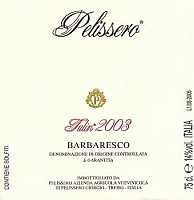
|
|
Barbaresco Tulin 2003 |
|
| Pelissero (Piedmont, Italy) | |
| Grapes: Nebbiolo | |
| Price: € 25.30 | Score: |
| This Barbaresco shows a brilliant ruby red color and nuances of brick red, moderate transparency. The nose denotes intense, clean, pleasing, refined and elegant aromas which start with hints of cherry and plum followed by aromas of violet, raspberry, strawberry, rose, tobacco, vanilla, licorice, pink pepper, cinnamon, chocolate and menthol. The mouth has good correspondence to the nose, a tannic attack and pleasing crispness, however balanced by alcohol, full body, intense flavors. The finish is persistent with flavors of cherry, plum and raspberry. A well made wine. Barbaresco Tulin ages for 18 months in cask followed by 9 months of aging in bottle. | |
| Food Match: Game, Roasted meat, Braised and stewed meat, Hard cheese | |
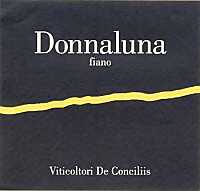
|
|
Donnaluna Fiano 2005 |
|
| De Conciliis (Campania, Italy) | |
| Grapes: Fiano | |
| Price: € 9.50 | Score: |
| This Fiano shows an intense greenish yellow color and nuances of greenish yellow, very transparent. The nose denotes intense, clean, pleasing and refined aromas that start with hints of apple, pear and plum followed by aromas of hawthorn, broom, hazelnut and peach. The mouth has good correspondence to the nose, a crisp attack and however balanced by alcohol, good body, intense flavors. The finish is persistent with flavors of apple, pear and plum. Donnaluna Fiano ages for 4 months in steel tanks and a small part in barrique. | |
| Food Match: Fried fish, Pasta and risotto with crustaceans and fish, Broiled crustaceans | |
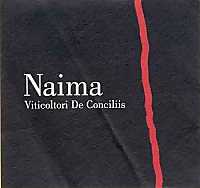
|
|
Naima 2003 |
|
| De Conciliis (Campania, Italy) | |
| Grapes: Aglianico | |
| Price: € 30.00 | Score: |
| Naima shows an intense ruby red color and nuances of garnet red, little transparency. The nose reveals intense, clean, pleasing, refined and elegant aromas which start with hints of black cherry, blackberry and plum followed by aromas of violet, blueberry, licorice, cocoa, mace, graphite, pink pepper, vanilla and menthol. The mouth has good correspondence to the nose, a tannic attack and however balanced by alcohol, good body, intense flavors, agreeable. The finish is persistent with flavors of plum, blackberry and black cherry. A well made wine. Naima ages for 12 months in barrique, 6 months in steel tanks and 4 months in bottle. | |
| Food Match: Roasted meat, Braised and stewed meat with mushrooms, Hard cheese | |
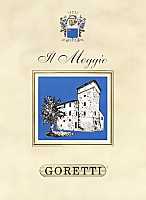
|
|
Il Moggio 2004 |
|
| Goretti (Umbria, Italy) | |
| Grapes: Grechetto | |
| Price: € 10.00 | Score: |
| Il Moggio shows a brilliant golden yellow color and nuances of straw yellow, very transparent. The nose denotes intense, clean, pleasing and refined aromas which start with hints of apple, pear and hazelnut followed by aromas of citrus fruits, hawthorn, pineapple, broom, plum and vanilla. The mouth has good correspondence to the nose, a crisp attack and however balanced by alcohol, good body, intense flavors, agreeable. The finish is persistent with flavors of apple. plum and hazelnut. Il Moggio ages in barrique followed by 4-6 months of aging in bottle. | |
| Food Match: Roasted white meat, Roasted fish, Stuffed pasta | |
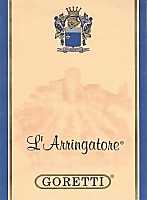
|
|
Colli Perugini Rosso L'Arringatore 2003 |
|
| Goretti (Umbria, Italy) | |
| Grapes: Sangiovese, Merlot, Ciliegiolo | |
| Price: € 14.00 | Score: |
| This wine shows an intense ruby red color and nuances of ruby red, little transparency. The nose reveals intense, clean, pleasing and refined aromas which start with hints of black cherry and plum followed by aromas of blueberry, blackberry, violet, vanilla, toasted, cocoa, cinnamon, tobacco and eucalyptus. The mouth has good correspondence to the nose, a tannic attack and however balanced by alcohol, good body, intense flavors. The finish is persistent with flavors of black cherry, plum and blackberry. L'Arringatore ages for 12 months in cask followed by 12 months of aging in bottle. | |
| Food Match: Roasted meat, Broiled meat and barbecue, Braised and stewed meat, Hard cheese | |
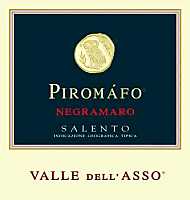
|
|
Piromafo 2001 |
|
| Valle dell'Asso (Apulia, Italy) | |
| Grapes: Negroamaro | |
| Price: € 17.00 | Score: |
| Piromafo shows a brilliant ruby red color and nuances of brick red, moderate transparency. The nose denotes intense, clean, pleasing and refined aromas which start with hints of black cherry, plum and blackberry followed by aromas of violet, tobacco, vanilla, undergrowth, licorice, pink pepper, carob and menthol. The mouth has good correspondence to the nose, a tannic attack and however balanced by alcohol, good body, intense flavors. The finish is persistent with flavors of black cherry, plum and blackberry. Piromafo ages for 12 months in cask followed by 6 months of aging in bottle. | |
| Food Match: Roasted meat, Braised and stewed meat with mushrooms, Hard cheese | |
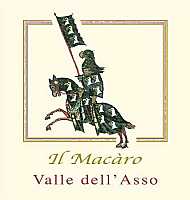
|
|
Il Macaro |
|
| Valle dell'Asso (Apulia, Italy) | |
| Grapes: Aleatico, Malvasia Nera | |
| Price: € 14.00 - 50cl | Score: |
| Il Macaro shows an intense garnet red color and nuances of brick red, moderate transparency. The nose denotes intense, clean, pleasing and refined aromas which start with hints of raisin, plum jam and fig jam followed by aromas of black cherry jam, caramel, date, vanilla, dried violet, tobacco and licorice. The mouth has good correspondence to the nose, a slightly tannic attack and pleasing sweetness, however balanced by alcohol, good body, intense flavors, agreeable. The finish is persistent with flavors of plum jam and black cherry jam. Il Macaro ages for 6 years in cask followed by 6 months of aging in bottle. | |
| Food Match: Fruit tarts, Piquant cheese | |
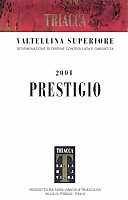
|
|
Valtellina Superiore Prestigio 2001 |
|
| Triacca (Lombardy, Italy) | |
| Grapes: Nebbiolo | |
| Price: € 27.00 | Score: |
| This Valtellina Superiore shows an intense ruby red color and nuances of brick red, moderate transparency. The nose denotes intense, clean, pleasing, refined and elegant aromas which start with hints of plum, cherry and violet followed by aromas of raspberry, rose, vanilla, tobacco, licorice, cinnamon, coffee, chocolate, leather and menthol. The mouth has good correspondence to the nose, a tannic attack and pleasing crispness, however balanced by alcohol, full body, intense flavors. The finish is persistent with flavors of cherry and plum. A well made wine. Valtellina Superiore Prestigio is produced with late harvested grapes, ages for 15 months in barrique followed by 8 months of aging in bottle. | |
| Food Match: Roasted meat, Game, Braised and stewed meat, Hard cheese | |
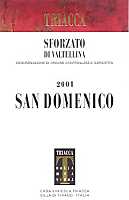
|
|
Sforzato di Valtellina San Domenico 2001 |
|
| Triacca (Lombardy, Italy) | |
| Grapes: Nebbiolo | |
| Price: € 26.00 | Score: |
| This wine shows a brilliant ruby red color and nuances of brick red, moderate transparency. The nose reveals intense, clean, pleasing, refined and elegant aromas which start with hints of cherry, raspberry and violet followed by aromas of plum, rose, strawberry, vanilla, tobacco, licorice, cocoa, cinnamon, leather and menthol. The mouth has excellent correspondence to the nose, a tannic attack and pleasing crispness, however well balanced by alcohol, full body, intense flavors, pleasing roundness. The finish is very persistent with flavors of cherry, plum and raspberry. A well made wine. Sforzato di Valtellina San Domenico is produced with grapes dried for 3 months and ages for 18 months in cask. | |
| Food Match: Game, Roasted meat, Braised and stewed meat, Hard cheese | |
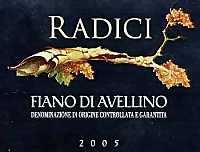
|
|
Fiano di Avellino Radici 2005 |
|
| Mastroberardino (Campania, Italy) | |
| Grapes: Fiano | |
| Price: € 12.00 | Score: |
| This wine shows a pale straw yellow color and nuances of greenish yellow, very transparent. The nose denotes intense, clean, pleasing and refined aromas which start with hints of plum, apple and pear followed by aromas of pineapple, citrus fruits, hazelnut, hawthorn and broom. The mouth has good correspondence to the nose, a crisp attack and however balanced by alcohol, good body, intense flavors. The finish is persistent with flavors of apple, plum and hazelnut. Fiano di Avellino Radici ages in part in steel tanks and in part in barrique. | |
| Food Match: Pasta and risotto with crustaceans, Broiled crustaceans | |
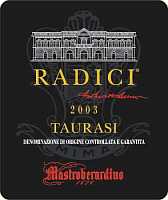
|
|
Taurasi Radici 2003 |
|
| Mastroberardino (Campania, Italy) | |
| Grapes: Aglianico | |
| Price: € 20.00 | Score: |
| Taurasi Radici shows an intense ruby red color and nuances of garnet red, little transparency. The nose reveals intense, clean, pleasing, refined and elegant aromas which start with hints of black cherry, plum and violet followed by aromas of blackberry, blueberry, tobacco, licorice, vanilla, mace, carob, cinnamon and menthol. The mouth has good correspondence to the nose, a tannic attack and however well balanced by alcohol, full body, intense flavors, agreeable. The finish is persistent with flavors of black cherry, plum and blackberry. A well made wine. Taurasi Radici ages for 24 months in cask and barrique followed by at least 12 months of aging in bottle. | |
| Food Match: Game, Roasted meat, Braised and stewed meat, Hard cheese | |
|
||||||||
|
DiWineTaste Polls
|
| |||||||
Privacy Policy | |||||||


| Copyright © 2002-2024 Antonello Biancalana, DiWineTaste - All rights reserved |
| All rights reserved under international copyright conventions. No part of this publication and of this WEB site may be
reproduced or utilized in any form or by any means, electronic or mechanical, without permission in writing from DiWineTaste. |